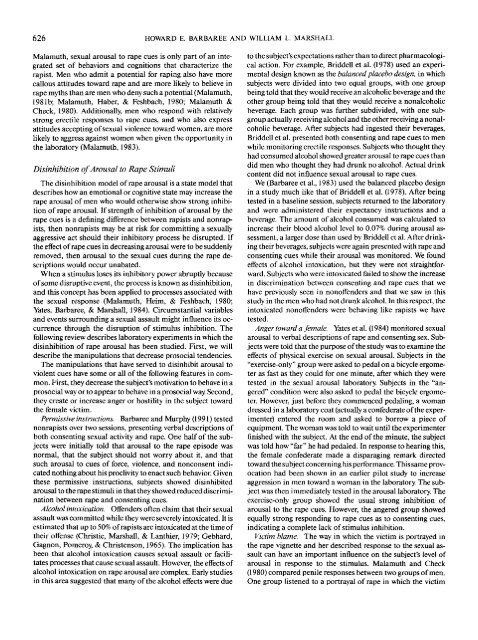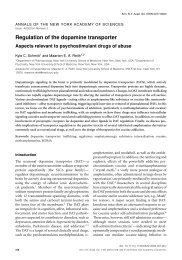The Role of Male Sexual Arousal in Rape: Six Models
The Role of Male Sexual Arousal in Rape: Six Models
The Role of Male Sexual Arousal in Rape: Six Models
Create successful ePaper yourself
Turn your PDF publications into a flip-book with our unique Google optimized e-Paper software.
626 HOWARD E. BARBAREE AND WILLIAM L. MARSHALL<br />
Malamuth, sexual arousal to rape cues is only part <strong>of</strong> an <strong>in</strong>te-<br />
grated set <strong>of</strong> behaviors and cognitions that characterize the<br />
rapist. Men who admit a potential for rap<strong>in</strong>g also have more<br />
callous attitudes toward rape and are more likely to believe <strong>in</strong><br />
rape myths than are men who deny such a potential (Malamuth,<br />
1981b; Malamuth, Haber, & Feshbach, 1980; Malamuth &<br />
Check, 1980). Additionally, men who respond with relatively<br />
strong erectile responses to rape cues, and who also express<br />
attitudes accept<strong>in</strong>g <strong>of</strong> sexual violence toward women, are more<br />
likely to aggress aga<strong>in</strong>st women when given the opportunity <strong>in</strong><br />
the laboratory (Malamuth, 1983).<br />
Dis<strong>in</strong>hibition <strong>of</strong> <strong>Arousal</strong> to <strong>Rape</strong> Stimuli<br />
<strong>The</strong> dis<strong>in</strong>hibition model <strong>of</strong> rape arousal is a state model that<br />
describes how an emotional or cognitive state may <strong>in</strong>crease the<br />
rape arousal <strong>of</strong> men who would otherwise show strong <strong>in</strong>hibi-<br />
tion <strong>of</strong> rape arousal. If strength <strong>of</strong> <strong>in</strong>hibition <strong>of</strong> arousal by the<br />
rape cues is a def<strong>in</strong><strong>in</strong>g difference between rapists and nonrap-<br />
ists, then nonrapists may be at risk for committ<strong>in</strong>g a sexually<br />
aggressive act should their <strong>in</strong>hibitory process be disrupted. If<br />
the effect <strong>of</strong> rape cues <strong>in</strong> decreas<strong>in</strong>g arousal were to be suddenly<br />
removed, then arousal to the sexual cues dur<strong>in</strong>g the rape de-<br />
scriptions would occur unabated.<br />
When a stimulus loses its <strong>in</strong>hibitory power abruptly because<br />
<strong>of</strong> some disruptive event, the process is known as dis<strong>in</strong>hibition,<br />
and this concept has been applied to processes associated with<br />
the sexual response (Malamuth, Heim, & Feshbach, 1980;<br />
Yates, Barbaree, & Marshall, 1984). Circumstantial variables<br />
and events surround<strong>in</strong>g a sexual assault might <strong>in</strong>fluence its oc-<br />
currence through the disruption <strong>of</strong> stimulus <strong>in</strong>hibition. <strong>The</strong><br />
follow<strong>in</strong>g review describes laboratory experiments <strong>in</strong> which the<br />
dis<strong>in</strong>hibition <strong>of</strong> rape arousal has been studied. First, we will<br />
describe the manipulations that decrease prosocial tendencies.<br />
<strong>The</strong> manipulations that have served to dis<strong>in</strong>hibit arousal to<br />
violent cues have some or all <strong>of</strong> the follow<strong>in</strong>g features <strong>in</strong> com-<br />
mon. First, they decrease the subject's motivation to behave <strong>in</strong> a<br />
prosocial way or to appear to behave <strong>in</strong> a prosocial way. Second,<br />
they create or <strong>in</strong>crease anger or hostility <strong>in</strong> the subject toward<br />
the female victim.<br />
Permissive <strong>in</strong>structions. Barbaree and Murphy (1991) tested<br />
nonrapists over two sessions, present<strong>in</strong>g verbal descriptions <strong>of</strong><br />
both consent<strong>in</strong>g sexual activity and rape. One half <strong>of</strong> the sub-<br />
jects were <strong>in</strong>itially told that arousal to the rape episode was<br />
normal, that the subject should not worry about it, and that<br />
such arousal to cues <strong>of</strong> force, violence, and nonconsent <strong>in</strong>di-<br />
cated noth<strong>in</strong>g about his proclivity to enact such behavior. Given<br />
these permissive <strong>in</strong>structions, subjects showed dis<strong>in</strong>hibited<br />
arousal to the rape stimuli <strong>in</strong> that they showed reduced discrimi-<br />
nation between rape and consent<strong>in</strong>g cues.<br />
Alcohol <strong>in</strong>toxication. Offenders <strong>of</strong>ten claim that their sexual<br />
assault was committed while they were severely <strong>in</strong>toxicated. It is<br />
estimated that up to 50% <strong>of</strong> rapists are <strong>in</strong>toxicated at the time <strong>of</strong><br />
their <strong>of</strong>fense (Christie, Marshall, & Lanthier, 1979; Gebhard,<br />
Gagnon, Pomeroy, & Christenson, 1965). <strong>The</strong> implication has<br />
been that alcohol <strong>in</strong>toxication causes sexual assault or facili-<br />
tates processes that cause sexual assault. However, the effects <strong>of</strong><br />
alcohol <strong>in</strong>toxication on rape arousal are complex. Early studies<br />
<strong>in</strong> this area suggested that many <strong>of</strong> the alcohol effects were due<br />
to the subject's expectations rather than to direct pharmacologi-<br />
cal action. For example, Briddell et ai. (1978) used an experi-<br />
mental design known as the balanced placebo design, <strong>in</strong> which<br />
subjects were divided <strong>in</strong>to two equal groups, with one group<br />
be<strong>in</strong>g told that they would receive an alcoholic beverage and the<br />
other group be<strong>in</strong>g told that they would receive a nonalcoholic<br />
beverage. Each group was further subdivided, with one sub-<br />
group actually receiv<strong>in</strong>g alcohol and the other receiv<strong>in</strong>g a nonal-<br />
coholic beverage. After subjects had <strong>in</strong>gested their beverages,<br />
Briddell et al. presented both consent<strong>in</strong>g and rape cues to men<br />
while monitor<strong>in</strong>g erectile responses. Subjects who thought they<br />
had consumed alcohol showed greater arousal to rape cues than<br />
did men who thought they had drunk no alcohol. Actual dr<strong>in</strong>k<br />
content did not <strong>in</strong>fluence sexual arousal to rape cues.<br />
We (Barbaree et al., 1983) used the balanced placebo design<br />
<strong>in</strong> a study much like that <strong>of</strong> Briddell et al. (1978). After be<strong>in</strong>g<br />
tested <strong>in</strong> a basel<strong>in</strong>e session, subjects returned to the laboratory<br />
and were adm<strong>in</strong>istered their expectancy <strong>in</strong>structions and a<br />
beverage. <strong>The</strong> amount <strong>of</strong> alcohol consumed was calculated to<br />
<strong>in</strong>crease their blood alcohol level to 0.07% dur<strong>in</strong>g arousal as-<br />
sessment, a larger dose than used by Briddell et al. After dr<strong>in</strong>k-<br />
<strong>in</strong>g their beverages, subjects were aga<strong>in</strong> presented with rape and<br />
consent<strong>in</strong>g cues while their arousal was monitored. We found<br />
effects <strong>of</strong> alcohol <strong>in</strong>toxication, but they were not straightfor-<br />
ward. Subjects who were <strong>in</strong>toxicated failed to show the <strong>in</strong>crease<br />
<strong>in</strong> discrim<strong>in</strong>ation between consent<strong>in</strong>g and rape cues that we<br />
have previously seen <strong>in</strong> non<strong>of</strong>fenders and that we saw <strong>in</strong> this<br />
study <strong>in</strong> the men who had not drunk alcohol. In this respect, the<br />
<strong>in</strong>toxicated non<strong>of</strong>fenders were behav<strong>in</strong>g like rapists we have<br />
tested.<br />
Anger toward a female. Yates et al. (l 984) monitored sexual<br />
arousal to verbal descriptions <strong>of</strong> rape and consent<strong>in</strong>g sex. Sub-<br />
jects were told that the purpose <strong>of</strong> the study was to exam<strong>in</strong>e the<br />
effects <strong>of</strong> physical exercise on sexual arousal. Subjects <strong>in</strong> the<br />
"exercise-only" group were asked to pedal on a bicycle ergome-<br />
ter as fast as they could for one m<strong>in</strong>ute, after which they were<br />
tested <strong>in</strong> the sexual arousal laboratory. Subjects <strong>in</strong> the "an-<br />
gered" condition were also asked to pedal the bicycle ergome-<br />
ter. However, just before they commenced pedal<strong>in</strong>g, a woman<br />
dressed <strong>in</strong> a laboratory coat (actually a confederate <strong>of</strong> the exper-<br />
imenter) entered the room and asked to borrow a piece <strong>of</strong><br />
equipment. <strong>The</strong> woman was told to wait until the experimenter<br />
f<strong>in</strong>ished with the subject. At the end <strong>of</strong> the m<strong>in</strong>ute, the subject<br />
was told how "far" he had pedaled. In response to hear<strong>in</strong>g this,<br />
the female confederate made a disparag<strong>in</strong>g remark directed<br />
toward the subject concern<strong>in</strong>g his performance. This same prov-<br />
ocation had been shown <strong>in</strong> an earlier pilot study to <strong>in</strong>crease<br />
aggression <strong>in</strong> men toward a woman <strong>in</strong> the laboratory. <strong>The</strong> sub-<br />
ject was then immediately tested <strong>in</strong> the arousal laboratory. <strong>The</strong><br />
exercise-only group showed the usual strong <strong>in</strong>hibition <strong>of</strong><br />
arousal to the rape cues. However, the angered group showed<br />
equally strong respond<strong>in</strong>g to rape cues as to consent<strong>in</strong>g cues,<br />
<strong>in</strong>dicat<strong>in</strong>g a complete lack <strong>of</strong> stimulus <strong>in</strong>hibition.<br />
Victim blame. <strong>The</strong> way <strong>in</strong> which the victim is portrayed <strong>in</strong><br />
the rape vignette and her described response to the sexual as-<br />
sault can have an important <strong>in</strong>fluence on the subject's level <strong>of</strong><br />
arousal <strong>in</strong> response to the stimulus. Malamuth and Check<br />
(1980) compared penile responses between two groups <strong>of</strong> men.<br />
One group listened to a portrayal <strong>of</strong> rape <strong>in</strong> which the victim










